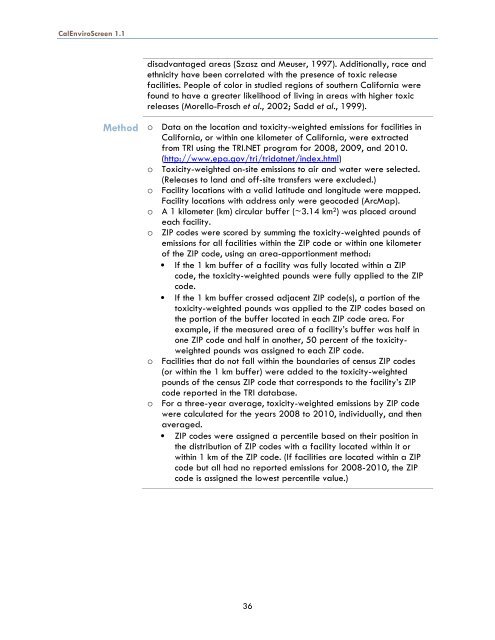CalEnviroscreen Version 1.1 - OEHHA - State of California
CalEnviroscreen Version 1.1 - OEHHA - State of California
CalEnviroscreen Version 1.1 - OEHHA - State of California
You also want an ePaper? Increase the reach of your titles
YUMPU automatically turns print PDFs into web optimized ePapers that Google loves.
CalEnviroScreen <strong>1.1</strong><br />
disadvantaged areas (Szasz and Meuser, 1997). Additionally, race and<br />
ethnicity have been correlated with the presence <strong>of</strong> toxic release<br />
facilities. People <strong>of</strong> color in studied regions <strong>of</strong> southern <strong>California</strong> were<br />
found to have a greater likelihood <strong>of</strong> living in areas with higher toxic<br />
releases (Morello-Frosch et al., 2002; Sadd et al., 1999).<br />
Method o Data on the location and toxicity-weighted emissions for facilities in<br />
<strong>California</strong>, or within one kilometer <strong>of</strong> <strong>California</strong>, were extracted<br />
from TRI using the TRI.NET program for 2008, 2009, and 2010.<br />
(http://www.epa.gov/tri/tridotnet/index.html)<br />
o Toxicity-weighted on-site emissions to air and water were selected.<br />
(Releases to land and <strong>of</strong>f-site transfers were excluded.)<br />
o Facility locations with a valid latitude and longitude were mapped.<br />
Facility locations with address only were geocoded (ArcMap).<br />
o A 1 kilometer (km) circular buffer (~3.14 km 2 ) was placed around<br />
each facility.<br />
o ZIP codes were scored by summing the toxicity-weighted pounds <strong>of</strong><br />
emissions for all facilities within the ZIP code or within one kilometer<br />
<strong>of</strong> the ZIP code, using an area-apportionment method:<br />
• If the 1 km buffer <strong>of</strong> a facility was fully located within a ZIP<br />
code, the toxicity-weighted pounds were fully applied to the ZIP<br />
code.<br />
• If the 1 km buffer crossed adjacent ZIP code(s), a portion <strong>of</strong> the<br />
toxicity-weighted pounds was applied to the ZIP codes based on<br />
the portion <strong>of</strong> the buffer located in each ZIP code area. For<br />
example, if the measured area <strong>of</strong> a facility’s buffer was half in<br />
one ZIP code and half in another, 50 percent <strong>of</strong> the toxicityweighted<br />
pounds was assigned to each ZIP code.<br />
o Facilities that do not fall within the boundaries <strong>of</strong> census ZIP codes<br />
(or within the 1 km buffer) were added to the toxicity-weighted<br />
pounds <strong>of</strong> the census ZIP code that corresponds to the facility’s ZIP<br />
code reported in the TRI database.<br />
o For a three-year average, toxicity-weighted emissions by ZIP code<br />
were calculated for the years 2008 to 2010, individually, and then<br />
averaged.<br />
• ZIP codes were assigned a percentile based on their position in<br />
the distribution <strong>of</strong> ZIP codes with a facility located within it or<br />
within 1 km <strong>of</strong> the ZIP code. (If facilities are located within a ZIP<br />
code but all had no reported emissions for 2008-2010, the ZIP<br />
code is assigned the lowest percentile value.)<br />
36















